The body wall of the earthworm covers the internal parts and also provides protection. Mucus protects the body wall from bacteria and other pathogens that lie on the body wall. Mucus also assists in respiration by keeping the skin moist. Body wall also serves as a receptor organ. The body wall consists of cuticle, epidermis, two muscular layers and the parietal layer of the coelomic epithelium
Cuticle: Cuticle is non-cellular layer which covers entire body. Cuticle is made up of mucopolysaccharides, collagen and gelatin. Cuticle is produced by the underlying epidermis. It gives protection to all the inner body parts.
Epidermis: It is formed by a single layer of thick ectodermal epithelial cells. There are four types of cells in the epidermis.
Large gland cells: The large gland cells are of two types namely, mucus secreting cells and albumen secreting cells. Mucous cells are largest cells which are ovoid, rounded at the distal end and narrow at the proximal end. The distal end contains mucous granules whereas the proximal end contains cytoplasm and nucleus. Also mucous cells are more in number.
On the other hand the albumin secreting cells are columnar and few in number. Secretory granules are uniformly distributed in these cells. The nucleus of these cells lies at the basal end.
Supporting cells: These cells are narrow and tall with an oval nucleus at the center. These cells are more in number than that of the gland cells.
Basal cells: Basal cells are the smallest cells of all the cell types of the epidermis. These cells have oval nucleus. These cells lie between the basal ends of the gland cells and supporting cells. The most important feature of these cells is that they are totipotent in nature.
Receptor cells: Three types of receptor cells are present in the epidermis namely epidermal receptor cells, buccal receptor cells and photoreceptor cells. Receptor cells are sensory in function. These cells occur in groups with their outer ends giving out hair-like appearance.
Muscle layers: Epidermis lies above the basement membrane. The basement membrane is a thin layer of connective tissue below which muscles are present. The muscles of the body wall are arranged in two layers namely outer circular muscle layer and the inner longitudinal muscle layer. The circular muscles are continuous and protractor muscles of setal sac are attached to this layer. Whereas the longitudinal muscles are arranged in bundles, alternating with the setal sacs. The contraction and relaxation of the circular and longitudinal muscles help in locomotion of the earthworm.
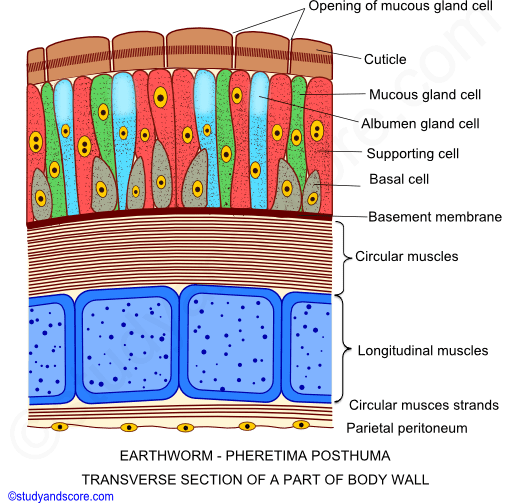
Parietal layer of coelomic epithelium: A strand of circular muscles is also present close to the parietal layer. The retractor muscles are attached to this strand. The innermost layer of the body wall is the parietal layer of peritoneum consisting of single layer of flat cells. It forms the outer coelomic epithelium, which is a derivative of the mesoderm. The parietal layer forms the septa and the primordial germ cells.
Coelom which is also known as perivisceral cavity is the space between the body wall and the alimentary canal. Coelom is filled with an alkaline fluid called as coelomic fluid. The coelom of earthworm is schizocoelom and it is divided into two compartments by the septa. The coelom of the first four segments is undivided. The first septum is thin and membranous. It lies between the fourth and fifth segments.
The intersegmental septa present between 5-6, 6-7, 7-8, 8-9 and 10-11 segments are thick and muscular. No septum is present between the 9-10 segments. These septa are not horizontal but are oblique in disposition forming six cones with their apices directed backwards. These septa form complete partitions without perforations on them.
The intersegmental septa of 11-12, 12-1 and 13-14 are transverse and non-perforated. The septum between 14-15 segments is typical as all the septa that follow it are characterized by the presence of minute oval or circular sphinctered pores. These pores are the characteristic of Pheretima posthuma.
By closing the septal pores, the flow of coelomic fluid is stopped making a particular region turgid and stiff. This turgidity helps in locomotion. Hence, coelomic fluid is described as hydraulic skeleton. In the coelomic fluid four types of cells are present. They are,
Phagocytes- Phagocytes are numerous and largest nucleated cells. They have several membranous folds on the surface. These are phagocytic in nature. They are produced by lymph glands which are situated on the dorsal blood vessel from 26th segment onwards till the last segment. There is a double row of glands in each segment. Each of these glands arises from the complex folding of anterior face of the septum and consists of masses of phagocytes.
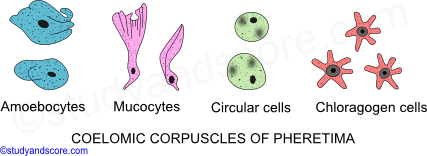
Chloragogen cells- These are small cells and are numerous in number. They are intense yellow in color and so they are also called as yellow cells. They have characteristic vesicular bulging. These are specialized cells derived from the inner coelomic epithelium. They contain yellowish granules called chloragosomes. They collect nitrogenous wastes from the coelomic fluid and from the blood supplied to the intestinal wall. When they are loaded with wastes, they drop into the coelom as free cells called eleocytes. They are then ingested by amoebocytes. In addition to excretion of nitrogenous wastes chloragogen cells perform the following functions:
Circular nucleated cells: They form about 10%of the coelomic cells and have characteristic markings on their surface.
Mucocytes: These are elongated cells with a nucleus at one side and expanded fan like process at the other end. These cells secrete mucus.
Pheretima posthuma moves by alternate contraction and relaxation of circular and longitudinal muscles of the body wall. The setae and the coelomic fluid also assist in the locomotion. The body of earthworm exhibits extension, contraction and anchoring in the anterior and posterior regions during locomotion.
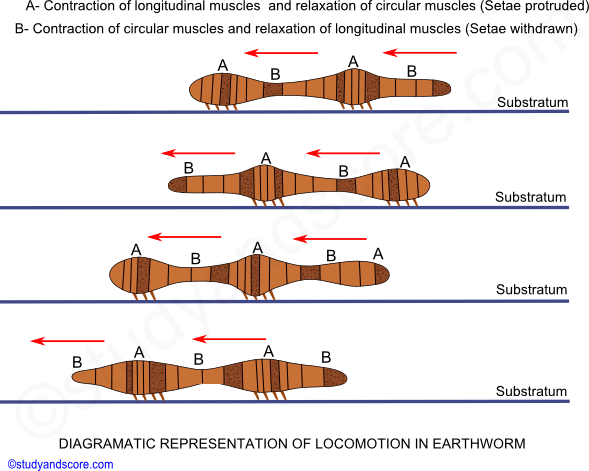
Circular and longitudinal muscles of the body wall are useful in extension and contraction of the body respectively. The setae are useful in anchoring. The coelomic fluid causes turgidity during locomotion of earthworm. Metamerism is beneficial for the burrowing worms. The individual segment or a short series of segments can be made rigid by contraction of muscles against coelomic fluid. Coelomic fluid cannot be displaced as it is trapped within each segment by septa. Thus efficiency of coelom as hydrostatic skeleton is improved. The contraction of the muscles is local but it passes backwards from anterior end, mush like a wave.
Forward progression of the anterior end begins by the contraction of the circular muscles of a few anterior segments. The wave of contraction of circular muscles passes backwards over the body of earthworm. When this wave passes over the anterior of few segments of the body, circular muscles at the anterior end of the body relax and the contractions of the longitudinal muscles sets in. thus series of waves of contraction of circular and longitudinal muscles also passes backwards one after the other continuously and pass backward during the locomotion of the earthworm. This movement is coordinated by the nervous system
Segments remain at rest when the longitudinal muscles contract to the maximum extent. The protractor muscles of setal sac also contract making the setae in that segments being protruded and directed backwards. With the relaxation of the longitudinal muscles and the simultaneous contraction of the circular muscles, the segments begin to move forwards on the ground. The retractor muscles of setal sacs contract at this time, making the setae in that segments being withdrawn.
Such series of local contractions and relaxations of circular and longitudinal muscles of the body wall are repeated in the anterio-posterior axis of the body. Earthworm can move upto 25 cm/min. On smooth surface the earthworm uses its mouth as sucker and pulls the body forward. The mucus secreted by the worm helps for easy gliding on the substratum.
The digestive system of Pheretima posthuma comprises of the alimentary canal and the associated glands. The alimentary canal is the straight tube extending from mouth to anus. The following are different parts included in the alimentary canal and also a description of associated glands is given.
Mouth: Mouth is present at the anterior end below the prostomium. Anterior margin of peristomium borders this crescent shaped opening. The mouth leads into the buccal chamber.
Buccal chamber: Buccal chamber is a short tube with thin and slightly floded walls. It extends upto the middle of the third segment. The buccal chamber is folloed by a pear-shaped pharynx.
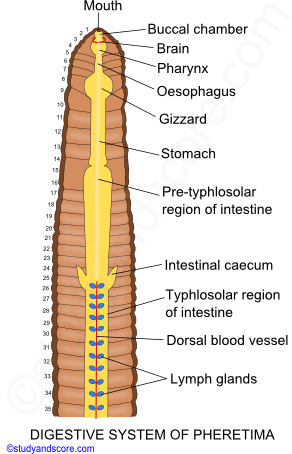
Pharynx- Pharynx is partly present in the third segment and partly it occupies the fourth segment. It is compressed dorso-ventrally because of the present o the dorsal pharyngeal mass or bulb. The lateral walls are pushed inward to form a narrow horizontal shelf on each side. The pharyngeal cavity is divided into a dorsal salivary chamber and a ventral conducting chamber by the lateral pharyngeal folds. The pharyngeal bulb which is considered as salivary gland, is made up of thick mass of musculo-vascular tissue and pharyngeal gland cells which produce mucus and a proteolytic enzyme. The saliva produced in the bulb is released into the salivary chamber.
Oesophagus- The pharynx leads into the oesophagus. It extends from the fifth segment to the eighth segment. Oesophagus is a short and narrow tube. In the eighth segment it is modified to form gizzard. The gizzard is an oval shaped, glandular region with thick walls of circular muscle fibers and is lined by internal cuticle. With the contraction of the muscles, the food is ground into fine particles in gizzard. Hence for this reason, gizzard is also known as the grinding mill.
Stomach: The gizzard is continued as a long, highly vascular, glandular tube like stomach. It lies from ninth to fourteenth segments. Stomach is internally lined by glandular cells and also the lining is thrown into foldings. The glandular cells are similar to the pharyngeal gland cells and these cells secrete proteolytic enzymes.
Intestine: The stomach is continued as a thin walled wide tube called as intestine. It extends from the fifteenth segment till the last segment. On the basis of the presence of the typhlosole, intestine can be distinguished into the following parts,
Pre-typhlosolar region- It lies in the segments from 15th to 26th. In 26th segment two short conical outgrowths, one on either side, are given off from the intestine called intestinal caeca. They extend forwards over three or four segments. These caeca are digestive glands and they secrete amylase.
Typhlosolar region- This part of the intestine extends from 26th segment till the last segment excluding 23, 24 and 25 segments. In this part, a median longitudinal fold called typhlosole is present. It increases the area of absorption of the digestive food. Typhlosole is poorly developed in Pheretima posthuma.
Post-typhlosolar region- This is the posterior part of the intestine occupying the last 23 or 25 segments. It is also called as the rectum. It opens out through anus. It temporarily stores the faecal pellets, which are defecated through the anus.
Process of digestion
The digestion in earthworm is extracellular. Earthworm obtains its nourishment from the organic debris present in the soil. So it is called detritivorous animal. Pharynx is ejected due to the inside out of the buccal chamber. Pharynx, with the help og its radial-dilator muscles, work as a suction-pump in feeding.
The organic food along with the swallowed soil particles is sucked into the pharynx, where it mixes with the salivary secretion. The mucin in the saliva lubricates the gut wall for the easy passage of food and also helps in the formulation of bolus. The proteolytic enzymes in the saliva partly digest proteins. Then the food reaches the gizzards. Its circular muscles and the thick cuticle grind the food into fine particles. In this state, the food is easily acted upon by the digestive enzymes in the stomach and intestine. The intestinal juice of the earthworm is comparable to the pancreatic juice of higher animals. All these enzymes like proteases, amylases and lipases act upon the finely ground food and digest the organic matter in it.
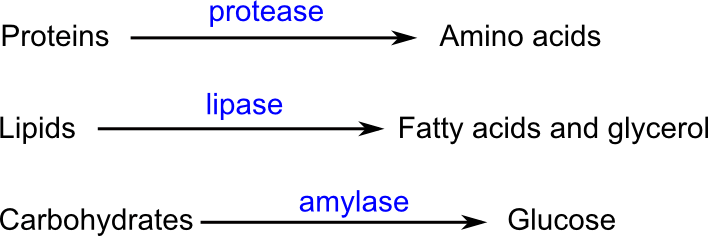
The digested food is absorbed by the intestinal epithelium in the typhlosolar region. Extensive capillary network of blood vessels of the intestine plays a vital role in absorption. The typhlosole helps in increasing the area of absorption.
The undigested food then passes to the rectum, where water is absorbed from the undigested food. Then the undigested matter is egested out through the anus in the form of worm castings.

- Share with your friends! -

Nalini Renu on Mar 19, 2019 at 06:17 am
This website is perfect. But some pictures are not fully show like transverse section..

Study Score on Mar 19, 2019 at 09:33 am
Thank you for your comments Nalini Renu. Transverse section is actually shown fully. What is missing in this or what else would you like us to include in this diagram?
Login to post your comment here...
- or with social Account -